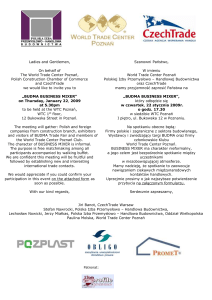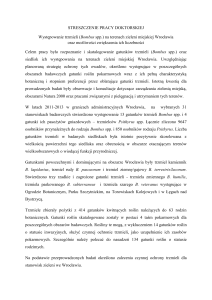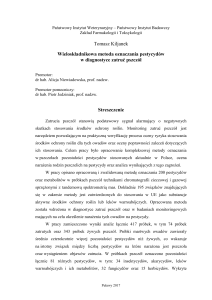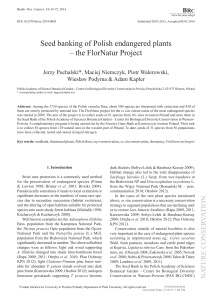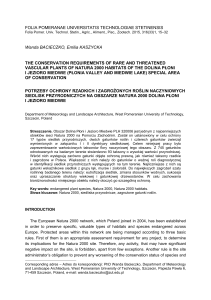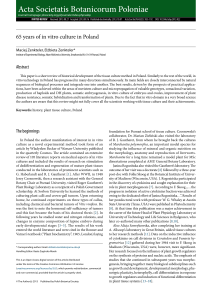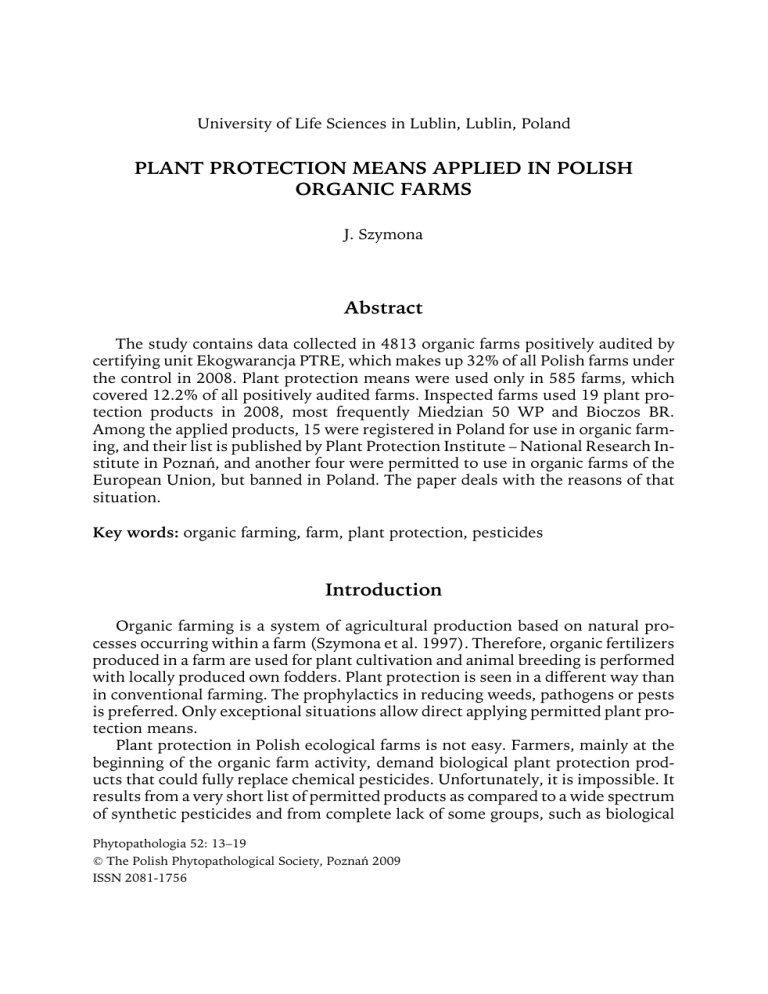
University of Life Sciences in Lublin, Lublin, Poland
PLANT PROTECTION MEANS APPLIED IN POLISH
ORGANIC FARMS
J. Szymona
Abstract
The study contains data collected in 4813 organic farms positively audited by
certifying unit Ekogwarancja PTRE, which makes up 32% of all Polish farms under
the control in 2008. Plant protection means were used only in 585 farms, which
covered 12.2% of all positively audited farms. Inspected farms used 19 plant protection products in 2008, most frequently Miedzian 50 WP and Bioczos BR.
Among the applied products, 15 were registered in Poland for use in organic farming, and their list is published by Plant Protection Institute – National Research Institute in Poznań, and another four were permitted to use in organic farms of the
European Union, but banned in Poland. The paper deals with the reasons of that
situation.
Key words: organic farming, farm, plant protection, pesticides
Introduction
Organic farming is a system of agricultural production based on natural processes occurring within a farm (Szymona et al. 1997). Therefore, organic fertilizers
produced in a farm are used for plant cultivation and animal breeding is performed
with locally produced own fodders. Plant protection is seen in a different way than
in conventional farming. The prophylactics in reducing weeds, pathogens or pests
is preferred. Only exceptional situations allow direct applying permitted plant protection means.
Plant protection in Polish ecological farms is not easy. Farmers, mainly at the
beginning of the organic farm activity, demand biological plant protection products that could fully replace chemical pesticides. Unfortunately, it is impossible. It
results from a very short list of permitted products as compared to a wide spectrum
of synthetic pesticides and from complete lack of some groups, such as biological
Phytopathologia 52: 13–19
© The Polish Phytopathological Society, Poznań 2009
ISSN 2081-1756
14
J. Szymona
herbicides (Wykaz... 2009). Even farmers who are advanced in organic farming,
know little on the prophylactics in nursery plantations, which is important and underlined in EU legal acts being obligatory in organic farming.
Material and methods
The study includes data collected from 4813 organic farms audited by certifying
unit Ekogwarancja PTRE. Within the studied group, 585 farms applying plant protection products were taken under consideration. Analysis included types of the
applied products, number of farms where a product was used, total amount of the
product and specification concerning the treated cultures: agricultural crops, vegetables, fruit trees, berries, etc.
Results
In 2008, the certifying unit Ekogwarancja PTRE audited and certified 4908
farms, including 4813 with positive results. The group included 3207 organic
farms. The others were in their first or second year of conversion into organic farming.
Plant protection means were applied in 585 farms (12.2% of all positively audited farms). These numbers do not suggest that remaining farms (almost 90% of
studied farms) had no problems with plant protection. Unfortunately, the majority
of farmers decided to get into organic farming, hoping for subsidies for that agricultural system. Their farms are extensive (Kuś 2008).
In small farms – several hectares – agricultural goods are utilized for own needs
or their families, while product manufacturing is incidental (Łuczka-Bakuła 2008).
In the case of good harvest, the surplus is sold on local market, often with no remarks that they are organic farming products. These farms most frequently produce cereals, sometimes potatoes with the largest problem – potato beetle, which
is manually removed.
In the organic farm group, there are also such, the owners of which live in distant cities. Land of their farms are sustainable meadows cut not more than once a
year. Neither fertilizers nor plant protection products are used in these farms,
whose area is often several hundred hectares (Kuś 2008).
The group of 585 farms, in which plant protection means were applied, belong
to producing farms (Ekogwarancja PTRE... 2009). In 2008 the studied farms used
19 plant protection products (Table 1), including 14 ones from a current list of Institute of Plant Protection in Poznań (Wykaz... 2009).
Miedzian 50 WP was most often used – it was applied in 252 farms, then
Bioczos BR – in 136 farms, Siarkol Extra 80 WP – in 35 farms, as well as Grevit 200
SL and Novodor 02 SC – in 30 farms (Table 1). Among the applied products, there
are some with active substance listed in EU Directive (Commission... 2008), although not registered in Poland. Applying these products is not contradictory to
Plant protection means applied in Polish organic farms
15
Table 1
Plant protection means applied in organic farming
Lot Number
no. of farms
Name of plant
protection
product
3
Amount
of applied
product
Plantations where the product was applied
4
5
1
2
1
252
Miedzian 50 WP
3,276.2 kg Fruit trees: apple, cherry, sweet cherry, plum, peach,
apricot, hazel, walnut
Berries: black currant, red currant, strawberry,
raspberry, chokeberry, blueberry, gooseberry, wild
strawberry
Root crops: potato, beet root
Vegetables: cucumber, tomato, red beet, pepper,
cabbage, onion, leek, pea, bean, radish, rhubarb, parsley,
carrot, broccoli, cauliflower
2
136
Bioczos BR
1,904.0 l Fruit trees: apple, cherry, tree nursery, peach, hazel
Berries: blackberry, strawberry, black currant, red
currant, raspberry, gooseberry, grape
Root crops: potato
Vegetables: French bean, pumpkin, parsley, cucumber,
pepper, cabbage, pea, dill, rhubarb, carrot, red beet
Ornamental plants: chrysanthemum
Herbs: valerian, melissa, thyme
3
35
Siarkol Extra 80
WP
4
30
Grevit 200 SL
75.8 l Fruit trees: cherry, peach, apricot, sweet cherry
Berries: black currant, red currant, gooseberry,
raspberry, strawberry
Root crops: potato
Vegetables: onion, carrot, parsley, cucumber, tomato,
pepper, broccoli, cucumber, bean, leek, rhubarb, French
bean, cabbage, pumpkin
Ornamental plants: chrysanthemum
Herbs: valerian, basil
5
30
Novodor 02 SC
77.0 l Root crops: potato
6
8
7
30
Biosept 33 SL
Biochikol 020 PC
714.0 kg Fruit trees: cherry, peach, pear, apple
Berries: black currant, strawberry, red currant,
gooseberry, raspberry
Root crops: potato, beet root
5.6 l Fruit trees: cherry
Berries: raspberry, strawberry, black currant, red currant
Root crops: potato
Vegetables: cucumber, tomato, bean, pumpkin, carrot
Herbs: thyme
111.8 l Fruit trees: cherry, apple, walnut, plum
Berries: strawberry, raspberry, black currant, red
currant, blackberry
Root crops: potato
Vegetables: cucumber, tomato, bean, pepper, rhubarb,
parsley, cabbage
16
J. Szymona
Table 1 – cont.
1
2
3
4
5
8
7
Cuproflow 375
SC
83.0 l Fruit trees: apple, cherry, plum, apricot, peach, pear,
sweet cherry
9
5
Bovecol
655.0 l Berries: strawberry, raspberry
10
14
Tiotar 800 SC
378.0 l Fruit trees: apple, cherry, plum, walnut, apricot, peach,
pear
Vegetables: cabbage, tomato, cauliflower
11
6
Antifung 20 SL
215.0 l Fruit trees: apple
Berries: raspberry, black currant
Root crops: potato
Vegetables: carrot
Herbs: thyme
12
9
Madex SC
19.2 l Fruit trees: apple, plum, peach, sweet cherry, cherry,
pear
13
4
Treol 770 EC
62.0 l Fruit trees: peach, cherry, sweet cherry, apple, plum,
pear
Berries: black currant, strawberry
14
1
Spruzit DP
15
4
Promanal 60 EC
16
4
Lime sulphur
(Calcium
polysulphide)
17
2
Beauveria bassiana
18
5
SpinTor 240 SC
19
3
Paroil
1.0 l Root crops: potato
34.0 l Fruit trees: apple, plum
2,130.0 l Fruit trees: plum, peach, cherry, pear, apricot, apple
120.0 l Berries: strawberry
3.7 l Fruit trees: apple, pear
Root crops: potato
Vegetables: cucumber, leek, broccoli, pepper
77.0 l Fruit trees: plum, apple, cherry
EU legal acts, while it is prohibited in Poland, according to Plant Protection Act
voted in on the 18 December 2003 (Ustawa... 2004 a) and amended in 2008
(Obwieszczenie... 2008).
Applying some products for plants, for which it was not registered, is another
issue. It may result from a very poor list of permitted agents and from economizing
by producers registering only the most popular preparations, i.e. generating the
largest income.
The Californian Liquid – that is forbidden in Poland for application not only in
organic farming – is among agents used in farms certified by Ekogwarancja PTRE...
(2009). Annex II to Commission Regulation... (2008) lists that preparation as permitted in organic farming; however, Polish law bans it. Discussion on Californian
Liquid application is being undertaken in various horticultural publications.
Plant protection means applied in Polish organic farms
17
Ekogwarancja PTRE... (2009) achieved the permission of Ministry for Agriculture
and Rural Development to test the agent under organic farming conditions, thus
the preparation can be found on a list of permissible means applied in farms certified by the unit (Zezwolenie... 2008).
Discussion
Organic farming law stresses the importance of prevention in plant protection.
Council Regulation (EC)... (2007) gives some examples of such prevention like
promoting natural enemies, using resistant species and cultivars, adequate crop
rotation and plant nursing. The regulation mentioned allows in some cases the use
of an approved plant protection product. In our country the list of approved plant
protection products for organic farming is supervised by the Plant Protection Institute – National Research Institute in Poznań (Wykaz... 2009). Plant protection
products presented in this study are on Institute’s list in majority. Too small number of the approved plant protection products provokes some farmers to use plant
protection means approved in the European Union but banned in Poland. The usage of banned plant protection products is treated by Certification Bodies as usage
of chemical pesticides (Ekogwarancja PTRE... 2009).
The majority of Polish organic farms are extensive (Kuś 2008). They do not apply any plant protection means. Only a small group is market oriented and sells
goods directly or delivers them to contracting companies (Łuczka-Bakuła 2008).
Dynamically developing organic food market encourages high quality production. Such production is not possible with prevention steps only, and plant protection products are needed. Unfortunately, extending the list of approved plant
protection products in immediate future is not planned (Matyjaszczyk 2008). The
few approved products are used for protection of many cultivars and species which
does not favour their efficacy.
Conclusions
1. The presented results and literature data indicate that plant protection
system in organic farming is unsatisfactory, and the number of farms applying
plant protection means is negligible.
2. Great interest of farmers in organic farming is a challenge for research
and administration to work out accessible ways of plant protection.
3. Intensification of studies on new and more efficient plant protection
products, as well as simplifying the procedures for biological products registration in Poland are necessary.
18
J. Szymona
Streszczenie
ŚRODKI OCHRONY ROŚLIN STOSOWANE W POLSKICH
GOSPODARSTWACH EKOLOGICZNYCH
Praca zawiera dane z 4813 gospodarstw ekologicznych, które w 2008 roku
uzyskały pozytywny wynik kontroli dokonanej przez jednostkę certyfikującą
Ekogwarancja PTRE (stanowi to 32% wszystkich polskich gospodarstw objętych
kontrolą). Tylko w 585 gospodarstwach stosowano biologiczne środki ochrony
roślin, co stanowi 12,2% wszystkich pozytywnie ocenionych gospodarstw. W
badanych gospodarstwach używano w 2008 roku 19 biologicznych środków
ochrony roślin. Najczęściej stosowano Miedzian 50 WP i Bioczos BR. Wśród
stosowanych preparatów znajduje się 15 środków zarejestrowanych w Polsce,
których lista jest publikowana przez Instytut Ochrony Roślin w Poznaniu, oraz
cztery dozwolone w rolnictwie ekologicznym Unii Europejskiej, lecz niedozwolone
w naszym kraju. W pracy podano przyczyny tego stanu rzeczy.
Literature
Commission Regulation (EC) No. 889/2008 of 5 September 2008 laying down detailed rules for the implementation of Council Regulation (EC) No. 834/2007 on organic production and labelling of
organic products with regard to organic production, labelling and control. Annex II. 2008.
Council Regulation (EC) No. 834/2007 of 28 June 2007 on organic production and labelling of organic
products and repealing Regulation (EEC) No. 2092/91. 2007. L 189/1.
Ekogwarancja PTRE Certifying Body. Wykaz wystawionych certyfikatów i ich zakres. 2009. Lublin.
[www.ekogwarancja.pl].
Kuś J., 2008: Ocena organizacyjno-produkcyjna gospodarstw ekologicznych w Polsce. In: Poszukiwanie
nowych rozwiązań w ochronie upraw ekologicznych. Ed. E. Matyjaszczyk. Instytut Ochrony
Roślin, Poznań: 21–37.
Łuczka-Bakuła W., 2008: Rynek żywności ekologicznej. Wyznaczniki i uwarunkowania rozwoju. PWE,
Warszawa.
Matyjaszczyk E., 2008: Kwalifikowanie środków ochrony roślin do stosowania w rolnictwie
ekologicznym. In: Poszukiwanie nowych rozwiązań w ochronie upraw ekologicznych. Ed. E.
Matyjaszczyk. Instytut Ochrony Roślin, Poznań: 38–47.
Obwieszczenie Marszałka Sejmu z dnia 25 czerwca 2008 r. w sprawie ogłoszenia jednolitego tekstu
ustawy o ochronie roślin. 2008. Dz.U. 133, item 849.
Rozporządzenie Rady 2092/91/EWG z dnia 24 czerwca 1991 r. w sprawie produkcji ekologicznej,
produktów rolnych oraz znakowania produktów rolnych i środków spożywczych. 1991. Dz.U. L
198: 1.
Szymona J., Studzińska B., Rabsztyn K., Jachymek P., Łopuszyński W., 1997: Kryteria ekologicznej
produkcji rolnej. Kielce.
Ustawa o ochronie roślin. 2004 a. Dz.U. 11, item 94 with amendments.
Ustawa o rolnictwie ekologicznym. 2004 b. Dz.U. 93, item 898 with amendments.
Wykaz środków ochrony roślin zakwalifikowanych do stosowania w rolnictwie ekologicznym. 2009.
Instytut Ochrony Roślin, Poznań. [www.ior.poznan.pl].
Zezwolenie MRiRW nr HOR.sor.4081/D-P/c-nb/5/2008 z dnia 16 czerwca 2008 r. In: Ekogwarancja
PTRE Certifying Body. Wykaz wystawionych certyfikatów i ich zakres. 2009. Lublin.
[www.ekogwarancja.pl].
Plant protection means applied in Polish organic farms
19
Author’s address:
Dr. hab. Jerzy Szymona, Department of Agricultural Ecology, University of Life
Sciences in Lublin, ul. Akademicka 13, 20-950 Lublin, Poland, e-mail:
[email protected]
Accepted for publication: 15.05.2009

